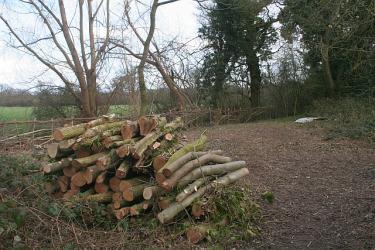Disposing of Woody Material
Introduction
After thinning or pruning your trees or cleaning your trails, be sure to dispose of the resulting woody waste. If left untended, these branches and brush pose a huge fire risk. Here are several economical and practical methods of disposal.
Utilizing Leftover Materials
During a thinning, trees are felled, limbed and cut to logs of varying lengths. The logs can often be used for firewood or construction, rather than left to be piled and burned.
• Sawlogs: Sawlogs are typically sold by the board foot or ton and can be sold in many areas, depending on the markets.
• Posts and Poles: Some areas have markets for posts and poles that permit the sale of logs as small as 2 to 3 inches in diameter. Small-diameter poles can also be used for home projects such as fences and deck supports.
• Firewood: Much of the material that isn’t suitable for sawlogs or posts and poles can be turned into firewood for sale or home use. Hardwoods are preferred, but Douglas fir, lodgepole pine and western larch are top conifer choices.
Methods of Wood Disposal
Once you have used as much material as possible, the next step is to treat the remaining woody residue, known as slash. Left untreated, slash can pose a significant fire hazard.
• Cut and Scatter: With this technique, understory trees, branches, brush and other ladder fuels are simply cut, sectioned into smaller pieces and scattered across the site. Note that cut and scatter does not eliminate fuels – it simply redistributes them. As the material decays over time, the fire hazard declines.
A common problem in dry forests is that slash may take a decade or more to decompose to the point where it no longer poses a significant fire hazard. Thus, cut and scatter should only be used where ladder fuels and slash loads are light.
Guidelines for the “Cut and Scatter” method:
- Cut material into small pieces and scatter to a depth of 12 inches or less.
- Cutting material in the fall provides more time for it to break down before the next summer’s fire season.
- Do not use this method of slash disposal within your home’s defensible space (within 30 to 100 feet).
- Use this method in low-density stands where existing surface fuel loads or ladder fuels are light, where decomposition will happen quickly and where a potential short-term increase in fire hazard is acceptable.
• Pile and Burn: With this technique, the material to be treated is cut, placed in piles and burned. This can be done either by hand or by machine.
This treatment is very effective at reducing slash, but there are significant risks. Landowners may be held liable if a fire escapes and becomes a wildfire. Additionally, burning usually leaves large, blackened circles and may cause scorch damage to other trees and vegetation if piles are too close or are burned too hot. Piles may also smolder for days or weeks and may roar back to life on warm, windy days.
Guidelines for the "Pile and Burn" method:
- Prior to constructing hand piles, determine the location and placement of each pile. Look for an open area away from structures, firewood, propane tanks, power lines and hazardous materials.
- Place piles at least 10 to 20 feet away from trees, snags, brush and downed logs. Place piles at least 50 feet from streams and drainages. Avoid placing piles in ditches.
- Place small branches, twigs and brush less than ½ inch in diameter at the bottom of the pile to provide kindling for easier ignition. Lay limbs and stems parallel and in the same direction to minimize air pockets. When piling on a hillside, place material parallel to the slope to prevent the pile from rolling.
- Pile sizes can vary but should be at least 4 feet in diameter and 4 feet in height.
- Cover hand piles if material is not going to be burned immediately.
- Cover hand piles when the pile is about 80 percent complete. Add additional material on top to hold the cover in place.
- Burn piles only when conditions are safe. Prior to burning, obtain a burn permit through your local fire department and follow guidelines.
- Have a shovel and water nearby and ready to use.
- Before leaving, check the piles to make sure they are no longer burning.
• Chipping: Chipping is an effective but more costly method of slash disposal. A layer of chips a few inches deep spread across the ground poses relatively little fire hazard. Chipping results in a neat appearance, and the material can serve as mulch, holding soil moisture, covering exposed soil and inhibiting the germination of weeds. Moisture levels and depth of the chips can affect decomposition rates and alter soil acidity. Chips should not be spread to a depth of more than a few inches and should not be used around the foundation of the home.
• Haul Away: Slash may be carried to a dumpster or a pickup bed and hauled away. This is labor intensive and best suited for relatively small amounts of material. The material can be hauled to a landfill or other disposal site. Check your local ordinances before pursuing this option.
Need more guidance? For more advice about how to dispose of woody material, consult a forester in your area or ask a question in our “Ask a Forester” forum.
How can I get more tips?
It’s simple! Enter your email below.

